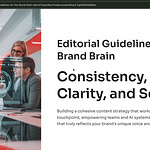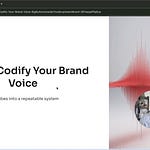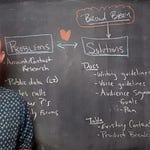As the Head of Content Strategy at Copy.ai, I've witnessed firsthand how AI-powered workflows are overhauling the way I create personalized, problem-specific content. Content that helps sales teams enable themselves and drives a measurable impact customer engagement.
If you’re new to this Substack, though, a bit about me - I've been knee-deep in the content marketing trenches for a while, tackling everything from SEO and lead generation to growth marketing. But what really gets my gears turning is making use of AI workflows and automation to rebuild go-to-market strategies and push beyond the obstacles that used to hold me back.
A good example? There’s no chance I would’ve had the bandwidth to run a Substack like this in 2023. It simply wouldn’t have been feasible if I also wanted to be a good father/husband and not just a killer marketer.
This means we needed to toss out the old bottom-of-funnel content creation playbook and drink our own champagne to make personalized, problem-specific content.
This personalized content is a major improvement for sales enablement and customer engagement. It gives sales teams the foundation for more relevant conversations with prospects. And it helps customers self-educate and self-qualify, reducing friction in the sales process.
How I Define “BOFU Content”
BOFU content focuses on solving highly specific problems with a specific platform that lends itself to a very specific solution. It emphasizes practical, actionable steps and outcomes, providing detailed, tailored guidance that connects the customer’s problem with the platform's capabilities.
For example, there is a concrete difference between “How to Write a Blog Post,” “How to Write a Blog Post with ChatGPT” and “How to Write a Blog Post with Copy.ai Workflows.”
I would argue that the first example (how to write a blog post) is TOFU — very educational in nature, not tool specific, and likely outlines the basic structure of types of blog posts.
The last two (how to write a blog post with ChatGPT and how to write a blog post with Copy.ai Workflows) would be BOFU:
Specific Problem
Specific Platform/Tool
Lends itself to a specific solution
Unlike top- or middle-of-funnel content, which educates or nurtures broadly, BOFU content is highly targeted and personalized. It demonstrates the value of a platform in achieving precise goals, such as writing an SEO-friendly blog post using a particular tool or expanding into a new market with a specific strategy.
Key Characteristics of BOFU Content:
Specificity: Addresses a narrowly defined problem or use case.
Actionability: Offers clear, step-by-step solutions.
Personalization: Tailored to individual user scenarios, often incorporating real-world data or customer-provided inputs.
Outcome-Oriented: Focuses on demonstrating tangible results achieved through the platform.
The purpose of BOFU content is to bridge the gap between customer intent and decision-making by showing how your platform is the best solution for their exact needs.
This type of content can be used for current prospects or existing customers. It simply depends on the problem they’re facing, and how well your tool or platform can deliver an answer to that problem.
Our Approach to BOFU Creation
The Playbook Pre-AI
Before AI, I was responsible for writing roughly 10 BOFU “how-to” guides each week. It was long, tiring, and often repetitive.
How We Did It:
Before AI, bottom-of-funnel (BOFU) content relied heavily on manual effort.
Content teams and subject matter experts wrote detailed how-to guides for solving specific problems using a platform.
For instance, if a user wanted to create an SEO-friendly blog post using a specific tool, a step-by-step guide would be crafted from scratch.
The process involved significant repetition—80% of the steps were often the same, with slight customization in the final stages for specific scenarios.
The Problem:
Time-intensive: Writing guides manually for every specific scenario was slow and resource-heavy.
Limited scalability: The repetitive nature of the process created bottlenecks, especially for high-volume needs.
Personalization challenges: Tailoring content for individual use cases while maintaining consistency required significant effort.
Note that this was how I created BOFU content in 2023 and before. We took a small change in 2024 as we implemented workflows into the process.
The Playbook with AI Workflows in 2024
This past year, we gave our BOFU content strategy an upgrade by using sales transcripts as the input. This was good, but it led to an influx of content that was hard to manage.
How We Did It:
Leveraged AI workflows to extract insights from sales call transcripts stored in a Notion content database.
Transcripts were analyzed to identify:
The problem discussed.
Steps to solve it using our platform.
Relevant quotes and key themes.
Generated guides that served as:
Sales enablement content.
Website articles targeting long-tail keywords for organic search.
Stored 9,500 such guides in a searchable database, enabling targeted repurposing for campaigns.
The Problem:
Data reliance: The success of this approach depended on accurate and comprehensive sales call transcripts, more specifically it meant even new sales reps needed to understand our GTM AI processes, which doesn’t always allow for learning curves.
Limited personalization: While efficient, these guides were not always tailored to individual customer profiles or real-time needs.
Maintenance: Ensuring the database remained relevant and up-to-date required ongoing effort.
Overall, this was a better approach than manual guide writing, but we needed “Goldie Locks” solution. Doing everything by hand led to low-volume, high-quality content. Doing it with transcripts led to super high-volume, likely mid-quality content (it needed some refreshes before publishing).
But now, I think we’ve nailed it for 2025.
The Playbook for 2025
We prepped for 2025 and built out a better system for writing guides. It will essentially create personalized experiences for folks, depending on the problem they describe for us.
How We Do It Now:
We built a AI-driven system that maps our workflows to specific problems and solutions.
Key features include:
A complete catalog of workflows, inputs, outputs, and expected results.
Personalized guide generation based on customer-provided data (e.g., LinkedIn profiles, problem descriptions, email addresses).
Expansion guides tailored for existing customers to encourage broader adoption of our platform.
Examples:
Customers input their problem via a form.
The system cross-references the problem with pre-loaded workflows.
Generates hyper-personalized guides detailing the solution, benefits, and steps for execution.
Why This Is Best:
Scalability: Automates the creation of BOFU content at scale without compromising on quality.
Hyper-personalization: Leverages real-time data to craft highly relevant content for individual users.
Sales enablement: Equips sales teams with precise tools to address customer needs effectively.
Efficiency: Minimizes manual effort while maximizing output, allowing marketing teams to focus on strategic initiatives.
Customer-centric: Positions our platform as a tailored solution provider, enhancing trust and engagement.
Looking Ahead:
We’re integrating these workflows into our resource center, replacing static content libraries with dynamic, personalized reports.
AI-driven BOFU content will continue evolving to provide even deeper insights and more actionable guidance for customers.
This approach aligns with our vision of empowering sales and marketing teams while delivering unparalleled value to our customers.










